
Delivering the fundamental science needed to sustain Australia's resource base
|
Goals-The Mission
|
CONTEXT
Water is essential for human existence, indeed for life’s beginning. The circulation of water and other fluids lubricates the deep-seated dynamics that keep Earth geologically alive, and its surface habitable. Several oceans’ worth of water may be present inside Earth, and the exchange of water and other fluids between the surface and the deep interior plays a crucial role in most Earth systems, including the evolution of the surface, the hydrosphere, the atmosphere/biosphere, and the development of giant ore deposits.
Subduction - the descent of oceanic plates into the mantle - carries water down into Earth’s interior; dehydration of the subducting crustal slabs at high pressure and temperature releases these fluids into the mantle, causing melting and controlling the strength, viscosity, melting temperature and density of rocks in the deep Earth, and the structure of major seismic discontinuities at 410 and 660 km depth. The partial return of some of these materials to the surface through mantle-plume activity provides a mechanism for tectonic cyclicity, which may have varied over geological time.
These effects dominate solid-Earth dynamics and make plate tectonics possible, but the origin, abundance, speciation and movements of fluids in the deep interior are largely unknown, and represent key issues in modern geoscience. 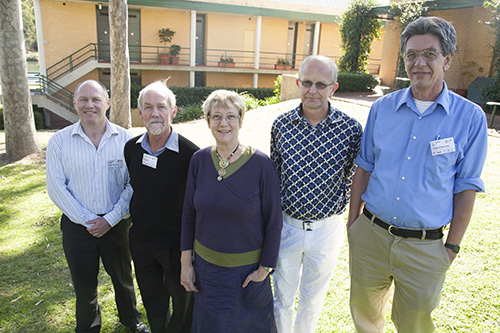
Until recently, a real understanding of the workings of Earth’s deep plumbing system has been tantalisingly out of our reach. Now, rapid advances in geophysics are producing stunning new images of variations in physical properties such as seismic velocity and electrical conductivity in the deep Earth, but interpretation of these images in terms of processes and Earth’s evolution is another key issue. It requires new kinds of data on deep-Earth materials, and especially on the effects of deep fluids and their circulation.
CCFS node leaders Cam McCuaig, Simon Wilde and Sue O’Reilly with representatives of the 2012 Science Advisory Committee, Stephen Foley and Stephen Grant.
To provide the knowledge needed to reach a new level of understanding of Earth’s evolution, dynamics and fluid cycle(s) through time, CCFS will integrate information across geology, tectonics, experimental and analytical geochemistry, petrophysics, geophysics, and petrophysical and dynamical modelling. These disciplines have traditionally represented “research silos”, but we will bring them together to provide a significant increase in our national research capability.
CENTRE RESEARCH
Research projects within the Centre are focused to provide maximum synergy for the scope enabled by the resource base. As it is not possible to encompass the full range of research about the Earth’s fluid cycle and deep Earth dynamics, all applied and mature strategic research will be carried out in parallel, supported by other funding sources. The basic research projects have been selected initially to capitalise on CCFS resources and to fit within the funding base.
The research activity of the CoE is built around three linked interdisciplinary and cross-institutional Themes, each with several Programs. We have structured these to promote synergy and interchange of ideas and information between the Programs, across the Themes, and especially across the three nodes. More detailed information is given in “Foundation Research Projects” and “Research highlights.”
In order to address one of the comments by the Science Advisory Committee that “we were sometimes led to pose the question ‘what does this have to do with fluids’ “ the overarching concept of projects contributing to understanding Earth Architecture and/or Fluid Fluxes has now been introduced. This conceptual base arose from very fruitful discussions at the Advisory Board Meeting of December 2012 and encapsulates the relationship of the CCFS projects to “fluids”.
“Architecture” is the roadmap for fluids
“Fluid Fluxes” represents the “traffic report”
All Research highlights and Projects are now keyed to this framework shown diagrammatically below:
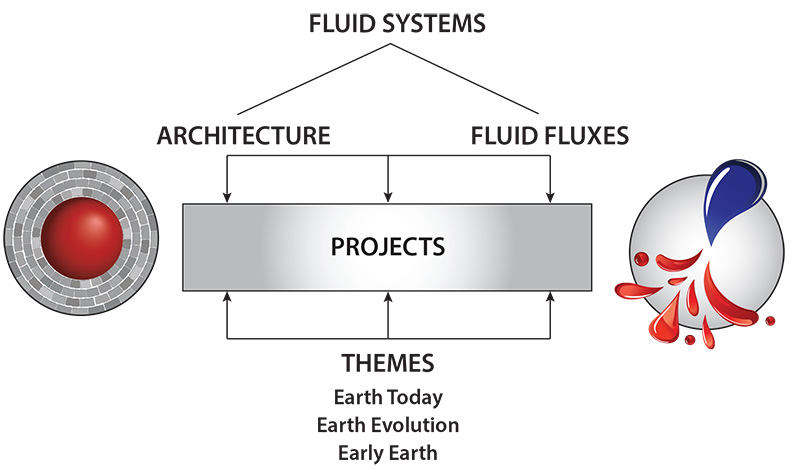
Science Advisory Committee Meeting 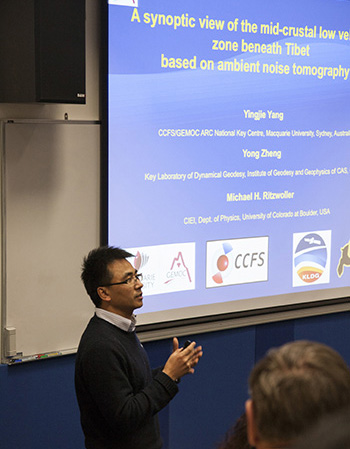
A combined meeting of all CCFS national Collaborating Institutions and the Geological Survey of Western Australia Partner was held at Macquarie University on 1-2 August 2012. Presentations were given by senior to early-career researchers and postgraduate students. The presentations were of outstanding quality, especially those of the postgraduates and early-career researchers. The Science Advisory Committee, Professors Stephen Foley, Stephen Grant and Julian Pearce, presented a comprehensive report praising the Centre structure and activities and providing some very constructive suggestions that are being implemented. Eclectic comments from the Report highlight different aspects of CCFS:
“Advisory Council members considered the standard of presentations to be excellent, and they produced several enthralling sessions….”
“The CCFS is already doing an excellent job at portraying a “corporate identity”, carrying on the fine tradition of the GEMOC group”
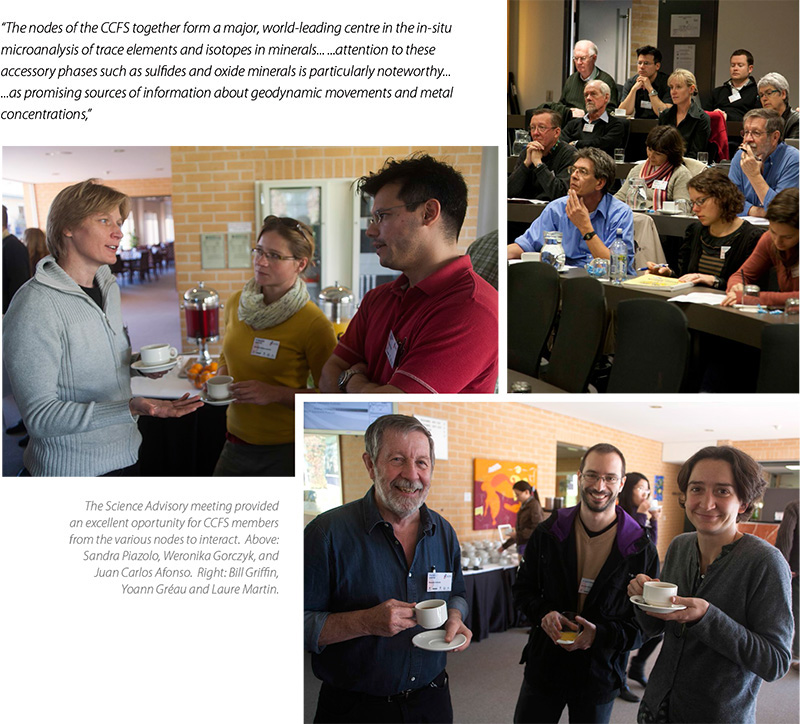
THEMES
Theme 1: Early Earth
The Early Earth - Its formation and fluid budget. This theme focuses on the nature of Earth’s early differentiation and the role of fluids. Ancient (>3 Ga) rocks may yield evidence for early life, and analysing the mass-independent fractionation of Fe and S isotopes will allow us to test the involvement of biological processes in ancient deposits.
The earliest record of Earth’s magnetic field will provide new information on when the core’s geodynamo formed and the geometry and intensity of its field, and will be used to track the movement of Archean tectonic plates. The geochemical nature and dynamic behaviour of the mantle in the early Earth will be assessed using in-situ analysis of targeted minerals from a variety of mantle rock types and tectonic environments, coupled with dynamic modelling.
Theme 2: Earth’s Evolution
Earth’s Evolution - Fluids in crustal and mantle tectonics; recycling of fluids into the deep mantle; hydrosphere, atmosphere and the deep Earth. Earth has evolved through cycles of crustal formation and destruction, punctuated by “tipping points”, when rapid cascades of interlinked events produced dramatic changes in the composition of the oceans, the oxygen levels of the atmosphere, the tectonic behaviour of the crust and mantle, and the distribution of mineral and energy resources. These events changed the distribution and behaviour of fluids in the deep Earth, and each altered Earth’s evolution irreversibly.
Key issues are: when did subduction start; how did it contribute to the Earth’s cooling; how has this process evolved through time? Isotopic studies will define the rates of continental growth vs recycling through time, and test linkages between crust and mantle events. Geophysical imaging and dynamic modelling will be used to build 3D models of subduction dynamics, thermal evolution and geodynamic cycles. Stable-isotope studies will track water and other fluids in their cycles through the Earth and the hydrosphere.
Theme 3: Earth Today
Earth Today - Dynamics, decoding geophysical imaging, and Earth resources. Geophysical imagery gives us a snapshot of the current status of the deep Earth but also carries the imprints of past processes. Realistic interpretation of these data will give us new insights into Earth’s internal dynamics and will have practical consequences, e.g. for resource exploration. We will develop thermodynamically and physically self-consistent dynamic codes to model complex processes and their expression in geophysical and geochemical observables. This code will be used to identify the processes that have controlled the fluid cycle through Earth’s history.
Measurement of the physical properties of potential deep Earth materials at extreme conditions will feed into petrophysical modelling of seismic data in terms of composition, temperature and anisotropy. Measurements of metal complexing at realistic conditions that mimic real ore-system fluids/melts will provide new ways to interpret observations on fluid/melt inclusions in minerals. We will investigate the role of organo-metallic compounds in metal transport, using the capabilities of the Australian Synchrotron, to understand the role of such compounds in the formation of large mineral systems.
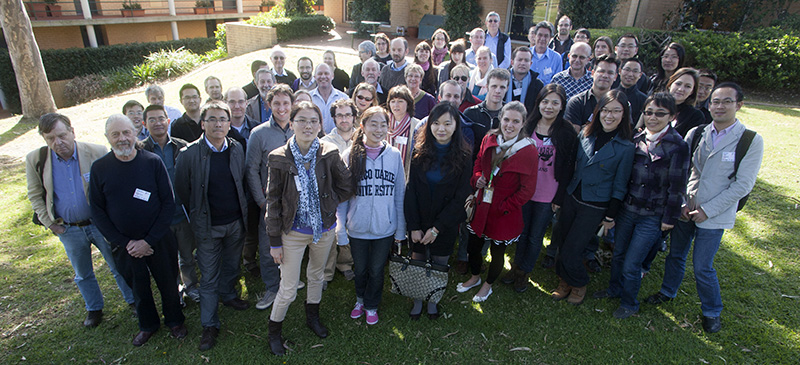
CCFS participants at the Science Advisory Committee Meeting in August 2012.

 ARC Centre of Excellence for Core to Crust Fluid Systems
ARC Centre of Excellence for Core to Crust Fluid Systems